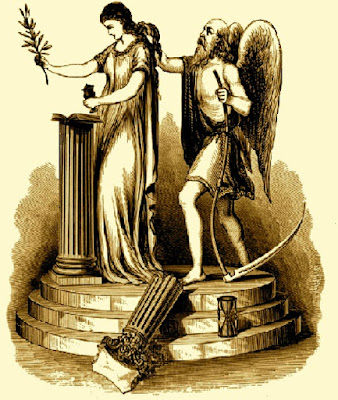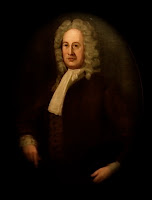 |
Magpie file photo
The oldest Bible in Masonic use in the United States? I believe so. This is a Koberger, printed in Nuremberg in the 1470s. It is owned by mighty Peninsula Lodge 99 in New Jersey, which displays it on its altar for its installation of officers every December. I served as Master of Peninsula in 2005, and placed my hands upon the pages of this VSL when being obligated. |
Something in a 1921 issue of The Builder magazine caught my attention a few weeks ago. It’s just a blurb shoehorned into the corner of a page:
THE OLDEST MASONIC BIBLE
Blair Lodge, Chicago, which is a representative body in the Fraternity and very successful in the administration of its affairs, owns one of the earliest imprints of King James’ version of the Bible, printed in 1615. It is asserted, according to the Illinois Freemason, that no Masonic lodge in America has an older Bible. During the tercentenary celebration of its translation a few years ago, this Bible was read from in several of the most prominent Chicago churches.
This Bible is nearly fifty years older than the one on which George Washington was initiated in Alexandria-Washington Lodge in Virginia, which latter was also used at the laying of the cornerstone of the national Capitol building in Washington. Up to about ten years ago, the tiler of Alexandria-Washington Lodge had represented to visiting Masons that theirs was the oldest Bible owned by any lodge in this country. None had disputed its honor until Brother Elmer E. Rogers of Blair Lodge brought him to further light.
Setting aside the glaring blunder of where America’s most famous Freemason had been initiated, this reads like a perfectly acceptable bite of Masonic trivia. It seems Blair Lodge is no longer extant, so I don’t know where this 1615 KJV is kept today. (I have an inquiry into Illinois Lodge of Research, and will update this post if I receive the info.)
Of course Washington was initiated in 1752 in the Masonic lodge at Fredericksburg, Virginia. The Bible used is owned to this day by Fredericksburg Lodge 4. It is a King James Version printed in 1668 (so The Builder erred also in its age, since it is 53 years younger than Blair Lodge’s KJV).
And you surely know of the other “Washington Bible,” that on which Washington took his first presidential oath of office in 1789 in New York City. That is a 1767 KJV, printed in London.
Reaching back in time to 1899, but coming closer to home, the Grand Lodge of New Jersey reported in its Book of Proceedings for that year that a Bible of even greater longevity was in Masonic use.
When this grand lodge held its 112th Annual Communication in Trenton on January 25-26 of that year, there was open upon the Masonic altar a very unusual Volume of Sacred Law. I don’t have that New Jersey Book of Proceedings, but thanks to the works of the Correspondence Committee of the Grand Lodge of Kentucky, the story from Trenton is told in that Book of Proceedings of 1899:
An interesting episode took place during the session of Grand Lodge. The Bible used upon the altar was one furnished by Brother George B. Edwards, and said to have been printed before the discovery of America by Columbus, the date being November 10, 1478. The presence of this remarkable book was the means of calling out the Grand Chaplain, whose few remarks are in excellent keeping with the antiquated volume.
You’re probably thinking it’s a Gutenberg, but it is not. This Bible is a product of Germany, but its printer was one Anthony Koberger (sometimes Koburger or Coberger), born circa 1445 and died 1513, of Nuremberg.
It was on this Bible that my hands rested while being sworn during my installation as Worshipful Master of Peninsula Lodge 99 one chilly night in December 2004. The Bible is owned by this lodge. Bro. George Edwards was a member of one of Peninsula’s ancestor lodges, but I do not know which. A number of lodges from in and around Hudson County, New Jersey came and went since the mid nineteenth century before Peninsula was formed in 2003—to be the last one of that family tree.
Perhaps he had no heirs, but for whatever reason, Edwards had arranged for this fifteenth century Bible to be safeguarded by the grand lodge, which had it tucked away in storage for about all of the twentieth century. A past grand master, who was a member of Peninsula, nudged the lodge to take possession of it, possibly in advance of my installation, but maybe a little earlier—I just don’t recall—and so we did. Peninsula does not display this VSL on regular meeting nights, but I’m sure the brethren still use it for the annual installation of officers.
It’s a strange Bible, as compared to what we all are used to. It is bilingual: Latin and the German of that period, and it does not contain all the books of the Holy Bible. It’s been so long, I just don’t remember which books were included. Unlike Koberger Bibles you’ll see on the web, this edition has no art in its pages, so, throughout, the pages are all text in two columns. The lettering is Gothic, making it tough on the eyes. The impressive color woodcuts were added to printings of later years.
But the age is legit. While I do not recall seeing this specific date November 10, 1478 printed in this Bible, I do remember the 1478. Before Columbus. Before Luther. Before King James. Amazing.
One can’t help but wonder at the possible dollar value of such a piece, and I remember seeing an advertisement in the Sunday New York Times Books section, somewhere around 2005, that listed a Koberger at $40,000, but I don’t know the year or condition of that item.
I’m no longer a member of mighty Peninsula (I became a New York Mason in 2015), but I was its Master in 2005. A pretty rough ride, frankly. I still keep in touch with a bunch of the brethren; they are very kind to remember me because I ceased being active there practically the minute the Master’s collar was lowered onto my successor’s shoulders on another cold December night in 2005. By that time, I was enjoying myself in various lodges in Manhattan—a visitor not attached to any problems that may have been fermenting behind the scenes.
 |
Courtesy Travis Simpkins
MW Gregory Scott |
The current MWGM of the Grand Lodge of New Jersey, Greg Scott, is from Peninsula Lodge, and that is the Koberger Bible seen in his official portrait, rendered by the talented Bro. Travis Simpkins.
Catholic Encyclopedia offers a useful write-up on the printer and his various Bibles. Koberger made Bibles into the sixteenth century. This Masonic lodge Bible is an early specimen of his, and later editions would improve in design and beauty over the years.

























































































